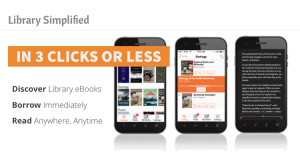
What if libraries could offer their books only through locations outsourced to for-profit vendors? And what if patrons had to go to different locations to find the collections purchased from each vendor?
Then, before reading, what if users had to navigate a complex registration process that could take well over an hour and create user accounts with the for-profit providers, who then try to sell them books while they browse for something to borrow?
While some libraries have outsourced library services to private contractors, this approach has been controversial, and most libraries would never accept this kind of commercialized and fractured service model for print books. We shouldn’t accept it for e-content either.
Libraries are in a time of historic transformation in which the transition from print to electronic media is reshaping public services. We believe it is incumbent on libraries to build new capacities to support new service models. Among the most important of these is the capability to serve our ebook collections directly to our users.
Ebooks are the fastest-growing format type at the New York Public Library (NYPL) and at many libraries across the country. To keep up with rising demand, library spending on ebooks grew at a compound annual growth rate of 38% for the past four years, from $30 million in 2009—according to a Public Libraries Survey conducted by the Institute of Museum and Library Services (IMLS)—to more than $110 million in 2013—according to a 2013 estimate from the Primary Research Group’s report on library use of ebooks.
Despite this rapid growth, library ebook use still lags far behind retail ebook sales, suggesting that libraries have the opportunity to circulate far more ebooks than they currently do. As of 2012, ebooks made up only 7% of circulation at US public libraries, according to a February 15, 2014, Library Journal report by Janet Hoffert. In the same year ebooks accounted for nearly a quarter of trade publishing revenues, and by 2013 more than half of unit sales, according to a July 2014 Book Industry Study Group report by Ted Hill and Kate Lara titled Digital Books and the New Subscription Economy.
Even more important than faster growth in circulation is the chance to vastly improve the user experience for patrons borrowing ebooks. While vendor-supplied offerings have improved somewhat in this regard, borrowing ebooks can still require many steps and may take far too long.
A new delivery channel
In 2012, recognizing that there was an opportunity to do better by building a library-owned delivery channel that would simplify and streamline the borrowing process, NYPL joined nine partners to propose just that to IMLS. We received a $500,000 National Leadership Grant, which NYPL matched, and began work on Library Simplified.
Maura Marx, acting director of IMLS, said, “We support work toward a national digital platform for libraries, and we believe that open, shared e-content solutions such as Library Simplified have the potential to be an important part of that platform. I’m thrilled we were able to help support this work in particular and excited to see libraries begin using the Library Simplified app. We are inspired by libraries’ ability to continuously innovate as they seek to improve services for all types of users.”
 The goal of Library Simplified is to eliminate complexity in the borrowing process, including minimizing the need for users to log in or register with third-party vendors. It will also avoid locking content to the particular device the user downloaded the content on. It will allow all the libraries that have purchased ebooks from more than one vendor, including OverDrive, 3M’s Cloud Library, and Baker & Taylor’s Access 360 product, to seamlessly serve all those collections through a single application. Users will simply search or browse for a title, borrow the book, and read it, all in three clicks or less. Libraries will no longer have to send patrons to different apps to access content purchased from different vendors or require users to establish online accounts, usernames, or passwords with multiple commercial providers. Perhaps most fundamentally, Library Simplified offers libraries the opportunity to bring ebook services in-house, serving patrons through an app the library owns and can customize and control.
The goal of Library Simplified is to eliminate complexity in the borrowing process, including minimizing the need for users to log in or register with third-party vendors. It will also avoid locking content to the particular device the user downloaded the content on. It will allow all the libraries that have purchased ebooks from more than one vendor, including OverDrive, 3M’s Cloud Library, and Baker & Taylor’s Access 360 product, to seamlessly serve all those collections through a single application. Users will simply search or browse for a title, borrow the book, and read it, all in three clicks or less. Libraries will no longer have to send patrons to different apps to access content purchased from different vendors or require users to establish online accounts, usernames, or passwords with multiple commercial providers. Perhaps most fundamentally, Library Simplified offers libraries the opportunity to bring ebook services in-house, serving patrons through an app the library owns and can customize and control.
“The Library Simplified app lets people focus on reading instead of setting up accounts and navigating multiple apps and interfaces. Just like our print collection, it should be easy to borrow and read an ebook, regardless of where it came from,” says Amy Calhoun of Sacramento (Calif.) Public Library, a Library Simplified partner.
An NYPL-based team led by product owner James English (coauthor of this article) and starring crack developers Leonard Richardson and John Nowak was formed in 2013. The team has been quietly working to build the library’s dream ebook solution, which is simple, easy to use, open, and interoperable and is in the final stages of development.
In the process, the team has engaged the larger digital publishing industry to form collaborative relationships with industry veterans such as Bill McCoy of the International Digital Publishing Forum (IDPF) and Readium Foundation, and Hadrien Gardeur of Feedbooks and Open Publication Distribution System (OPDS). As a result of these collaborations, the application will take advantage of all latest advances in EPUB 3, EDUPUB, and the Open Web. EPUB 3 and EDUPUB are industry standards for digital content publication, and Library Simplified will be one of the first ebook reading applications to take advantage of these emerging standards. It will also showcase advanced cross-platform rendering technology from the Readium Foundation. Together these innovative new technologies will support improved accessibility, portability, and interoperability.
Discoverability
Another important advancement is Library Simplified’s use of OPDS. This new open protocol is based on the same Open Web standards that helped newspapers and journals expose and publish their content online. The Library Simplified team is working to extend the OPDS standard to make sure it accommodates library lending and is compatible with new commercial e-reading platforms, such as Mantano, Aldiko, and others. The resulting extension of OPDS provides a standard open architecture for the machine-to-machine interface between circulation services, metadata services, and content hosting services. By using OPDS, libraries can expose their content to the web and to third-party interfaces, as well as their own online catalogs and websites using a stable open standard (as opposed to proprietary vendor APIs). This will help make library collections more discoverable online and also reduce the degree to which libraries are locked to any single vendor.
Back in control
In order to simplify the account experience and put libraries back in control of their relationships with users, Library Simplified will be using an Adobe Vendor ID to validate users, so patrons will no longer have to create or remember an Adobe user identification number. This is an important first step, and as Library Simplified developer Richardson explains, “Library Simplified really gives libraries’ relationships with their patrons back to them instead of those relationships being held by a third party.”
Accessibility by people with vision and hearing impairments has also been a priority. The team is working closely with advocacy groups like the Daisy Consortium and leveraging the EPUB 3 format to ensure that Library Simplified offers the best possible experience for the hearing and visually impaired.
Another priority has been empowering libraries and their staff members to serve readers through recommendations and readers’ advisory, putting the librarians back in library ebook service. We created browse lanes in Library Simplified for staff picks and readers’ advisory lists.
In order to ensure that publishers are supportive, Library Simplified will support multiple digital rights management (DRM) regimes. It will launch with Adobe DRM and, over time, add other DRM options—including Sony’s URMS and the open source Readium Content Protection technology—as those options mature and gain acceptance. Since the DRM will be applied on the distributor’s server before a file is passed to the Library Simplified application, neither libraries nor their distributors will need to seek any permission from publishers or modifications to their publishers’ contracts, nor will libraries need to modify their agreements with distributors.
Another priority has been empowering libraries and their staff members to serve readers through recommendations and readers’ advisory, putting the librarians back in library ebook service. We created browse lanes in Library Simplified for staff picks and readers’ advisory lists.
When asked about these features Lynn Lobash, NYPL’s manager of reader services, explained, “When staff members read something that makes them want to shout and insist everyone read it, they submit that title as a staff pick and it becomes part of the browse lane. Our staff reads widely across audiences (kids, young adults, adults), genres, and formats, and any title that moves them qualifies as a staff pick. This is what makes our staff picks so much broader than what you see on Amazon or at Barnes & Noble.” Staff members who submit picks are asked to include a brief annotation describing what about the book makes it exemplary.
The readers’ advisory lists are similar except that they are created from questions asked by real readers. “We throw one question a week out to our staff and all their recommendations are compiled into a list. Much as in class when one student asks a question, many in the class benefit from the answer, we believe the same is true for readers’ advisory questions. For example, we created read-alike lists for readers who like Haruki Murakami and readers who enjoyed the Game of Thrones series, A Song of Ice and Fire,” explains Lobash.
Readers’ advisory has long been a staple of librarianship and we are excited to reintroduce it to our ebook service. As Lobash explains, “Readers look to librarians for recommendations. They see us as expert advisors who can help navigate the thousands and thousands of titles from which to choose. One of the trickiest and most rewarding tasks at the library is matching readers with a book they will enjoy, and many of our staff members really shine at it.”
Available to all
Although the Library Simplified app has been designed by NYPL and its grant partners and built by the NYPL team, one of the key goals of the project is to allow library systems to use it, so the application will be open source and available to libraries everywhere to customize and launch for free.
To make it easy for other libraries to deploy, Library Simplified will be packaged as a virtual server, and libraries that want to create their own implementation of it will have multiple options. They can set up their own version on their own servers or in the cloud. Once the application is deployed, libraries will be able to configure it to their ecosystem of vendors and technologies though simple settings. Each library will link its version to its own content service provider accounts (OverDrive, 3M, or Baker & Taylor). The team has tried to make deployment of the application as easy as possible and we believe it should be well within the capabilities of most libraries. Alternatively, if libraries don’t want to or can’t host their own instance, NYPL can likely do this work for them. We are in the process of developing this service model; if you think your library is interested, reach out to us to discuss what you need and how we can help.
In addition to vast improvements in the user experience, Library Simplified can open doors for libraries to begin exploring alternative content sourcing strategies. Many systems and consortia, including those in Arizona, California, Illinois, Massachusetts, and North Carolina, are building open access and licensed content collections for use by constituents statewide. Library Simplified is designed on the principle of interoperability and meant to support an ecosystem with a mix of different content sources, including both content sources from vendors and self-hosted collections, so Library Simplified will allow libraries to aggregate content from multiple sources (for example, a statewide collection hosted by a library system along with a locally procured collection from a vendor). This will enable libraries to support regional authors and publishers through self-hosting projects while preserving access to existing commercial services without having to make trade-offs that fracture the user experience.
We hope you will join us as we launch Library Simplified and turn the page on a new era of library e-content service.


